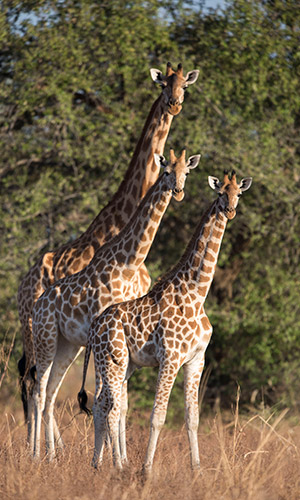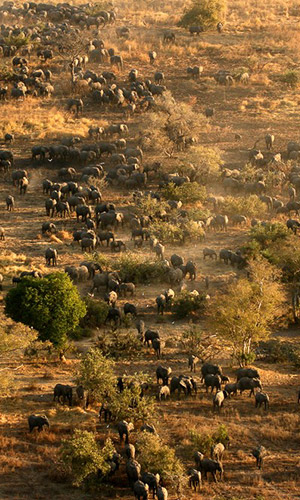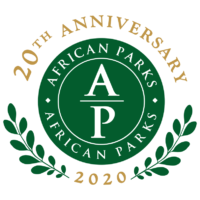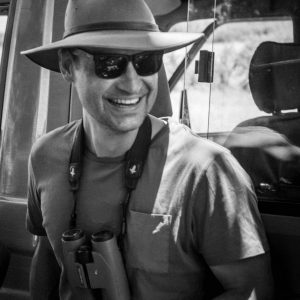Trip Inspiration
Previous Expeditions


As one of three national parks in Chad, Zakouma National Park forms an integral part of the conservation of flora and fauna in the region. The Chadian government has been committed to protecting this natural heritage and invited African Parks to restore and manage the Greater Zakouma Ecosystem in 2010. Since then, the park has risen from the ashes to become an unlikely symbol of hope for people and animals alike, and its transformation underscores crucial links between security, sustainable livelihoods, and wildlife conservation.
Considered to be one of the last strongholds of plains game in the Sudano-Sahelian zone, Zakouma – situated in south-eastern Chad – is 3000 km2 of untamed African wilderness. Due to its close proximity to the centre of the Chadian Basin, the terrain of the park is almost exclusively flat with the exception of the beautiful granite inselbergs found in the south-west near Ibir.
The Salamat river and its tributaries flood the eastern part of the park in the wet season and, as these inundated areas dry, the remaining water serves to congregate mammal and bird diversity in extraordinary numbers. Zakouma offers a wildlife experience without comparison on the African continent.
Conservation and Community
Mobile camping
Culture
Wildlife
Birdwatching
Photography

Expeditions to Zakouma typically include 7 nights in the park (accessed via charter flights from/to N’Djamena) staying at the African Parks operated Camp Nomade. This simple and charming tented camp, influenced in design by the Sahel’s nomadic culture, is perfectly located on the Rigueik Pan – the epicenter of animal and bird congregations in the park. Camp Nomade is an intentional use and invitation-only camp, for those seeking to be more deeply involved in philanthropy and African conservation.
In addition we also have access to a small, well-equipped fly camp which we use to explore remote corners of the park. Typically we’ll choose a spot along the Salamat river or find a remote pan to base ourselves. It really is an adventure in the true sense of the word.
Notable mammals in this sanctuary for West and Central African biodiversity include the Kordofan giraffe, red-fronted gazelle, Lelwel’s hartebeest, tiang, patas monkey and pale fox.
Herds of orange tinted Central African Savannah buffalo are often seen together with cattle egrets on the edges of the pans and swamps. A healthy population of roan antelope means that herds of over 50 can be seen grazing alongside Tiang and Lelwel’s hartebeest. Seeing the elephant herd is a highlight and the numbers have now recovered to over 500.
The birdlife in Zakouma is by far one of the highlights of any trip to the park. Species that one is accustomed to seeing only in pairs elsewhere in Africa are found here in flocks of well over 500.The Black crowned crane is seen in groups of over 2000, pelicans move in lines through fish infested pools, and the array of raptors include Beaudouins snake eagle and Grasshopper buzzard.
Night drives in Zakouma reveal an abundance of Africa’s smaller predators and one is almost guaranteed of regularly seeing serval, pale fox, civet and African wild cat during ones stay. This said, all the main predators are found in the park with lion common, leopard, cheetah and caracal seen occasionally, and striped hyena and aardwolf also occurring.
“A pride of hunting lions at Adelei pan and several proud looking Roan antelope bulls en-route set the tone. Arriving at the edge of the expanse of Tororo pan we started the now familiar routine of glassing the pans, marvelling at the abundance and diversity of life and juggling binoculars, cameras, field guides and species lists. Grasshopper buzzards were abundant with several always in view floating overhead or perched in fringing woodlands. Other raptors at the pan included Beaudouins snake-eagle, Long-legged buzzard, a pale morph Wahlbergs eagle, a melanistic Gabar goshawk, Western marsh harrier, Bateleur, and several Tawny eagles who had joined Ruppels, White-backed and Lappet-faced vultures for a drink and bathe in the pan. Nearby, a shy Serval cat made himself invisible in the grass only metres from the vehicle, bounding out when he eventually lost his nerve. Buffalo, Kob, Lelwel’s hartebeest, Tiang, Bohor reedbuck and Defassa waterbuck were all visible from any point on the pan and we added Greater Kudu to the antelope list with Patas monkeys and some Hartebeest in the frame alongside her. A conservative estimate totalled 110 Roan seen in the morning which consisted of three herds and various peripheral bachelor groups.
”
AE guide, Mark McKenzie

Zakouma National Park is managed by African Parks in partnership with the Chadian Government. In 2010, the Chadian Government and European Union approached African Parks to assume management responsibility of the park with the aim of protecting the regions incredible biodiversity and to create a space place for people and wildlife.
The mandate agreement was signed in June 2010, and African Parks began managing the park and its periphery that October. In October 2017, we doubled our footprint around Zakouma by signing an MoU with the Government to manage the Greater Zakouma Ecosystem, which includes the Siniaka Minia Faunal Reserve and other critical wildlife corridors.

“Zakouma really is an unforgettable place. There are so many highlights it is difficult to pin down, what makes a safari here so amazing. For some it is the incredible abundance on the pan systems–thousands of waterfowl, cranes, shorebirds and pelicans jostling and honking and probing day and night. Others just love the wildness and sense of place. Tracking the huge elephant herd is certainly an incredible experience – on my last safari we hid behind a bush watching upwards of 400 elephants cross a dry stream bed in front of us. Then there are the Quelea, late in the season the flocks are more like a biblical swarm, numbering tens of millions of individuals that appears as a gigantic, fluid creature at dawn and dusk. Outstanding night drives – some of the best, producing an amazing array of nocturnal creatures. A visit to the community areas surrounding the park feels perhaps even wilder and more remote than the park itself! The weekly markets in remote outposts offer a visual feast of colour and an amazing insight into the peoples lives in this harsh and beautiful land.”

“Seasonal pans explode with thousands of white-faced whistling ducks, clouds of red-billed queleas and a carpet of black crowned cranes, ochre orange buffalo brighten the ubiquitous herds, an estimated 150 lions’ prey on the diverse plains game and the elephants are bizarrely accepting of humans on foot.
This park tells the conservation story and significant achievements of African Parks, their partners and the Zakouma community. The African Parks team on the ground, led by Leon Lamprecht, contribute so much to the Zakouma success – determined, efficient, ambitious, and an inspiration to those involved in protecting Africa’s wild spaces.
If you’re after remote wilderness, feet-in-the sand adventure and a desire to be witness to, and a part of, a conservation effort which in many respects is the flag bearer for Africa, an expedition to Zakouma should be top of your list.”


Join our mailing list to receive The Expedition Post newsletter

